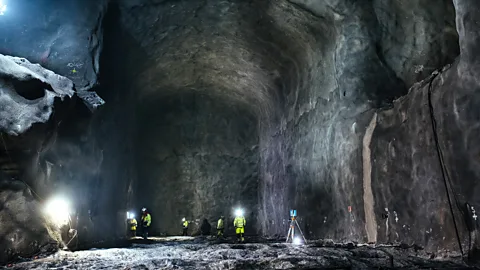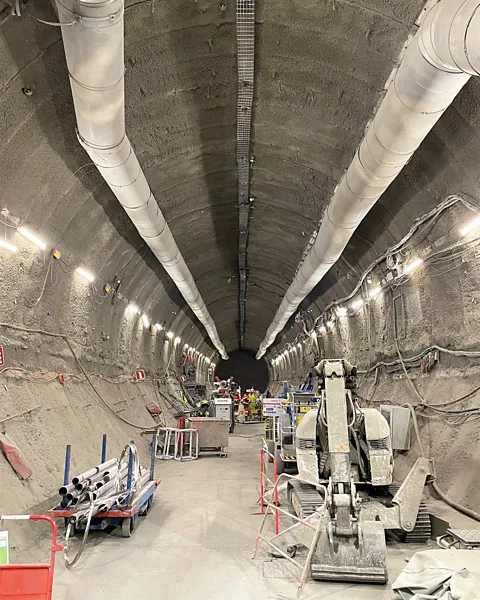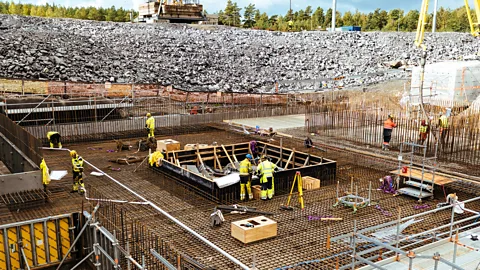How to build a nuclear tomb to last millennia
 Tapani Karjanlahti/ TVO
Tapani Karjanlahti/ TVONuclear waste remains toxic for thousands of years. How do you build a storage facility that will keep it safely buried for millennia?
It is a chilly day early in the summer. But 1,500ft (450m) beneath the rolling hills of the Champagne region in northeastern , it feels much warmer.
This facility's fluorescent lights are bright, and the air is dry. I can taste the dust in the atmosphere. The heavy emergency respirators I have to lug with me are a reminder of the dangers I might face this far underground.
Then I start to become disorientated by the rough, criss-crossing rocky ages of the underground laboratory, the hum of hidden electronic equipment and the lack of people. How do I get back to the lift?
I turn a corner, and there in front of me is a huge chamber, so large that I think for a moment that I have stumbled into a tomb of the pharaohs. But it hasn't been built by the Ancient Egyptians. It was instead carved out of the rock as a burial place for some of the most radioactive substances on Earth: intermediate and high-level nuclear waste.
How do you go about deg, building and operating structures that take decades to plan and even longer to build, that operate over centuries and must survive for 100,000 years, and that contain some of the most dangerous materials on the planet?
Four hours' drive east of Paris, the 2.4km (1.5 miles) of tunnels are home to countless scientific experiments, construction technique testing and technological innovations. 's National Radioactive Waste Agency (Andra) needs these to demonstrate to the regulators if it is to be awarded a licence to build a geological disposal facility (GDF) next to the tunnels.
Geological disposal facilities for nuclear waste are, or will be, some of the largest underground structures humanity has ever built. They are planned, in development, about to start construction or about to open in the UK, , Sweden, Finland and around 20 other countries.
 Andra
AndraFinland was the first country in the world to build a deep geological disposal facility for spent fuel, and it has now conducted the first stage of the trial disposal of the fuel. In Sweden, construction of a GDF is about to start at Forsmark, two hours' drive north of Stockholm, and a similar facility, Ciego, is expected to be built in relatively soon. In Britain a possible site for such storage has yet to be chosen.
GDFs are epically large, expensive and controversial underground structures designed to contain the most radioactive and long-lived waste produced by the nuclear industry. Currently stored on the surface in facilities such as that at Sellafield in the UK, and at La Hague in , this waste can include components of nuclear reactors, graphite from reactor cores, spent fuel and the liquid byproduct from the reprocessing of spent fuel from nuclear reactors.
On a computer screen, the plan for any GDF like this looks like a huge, multi-level nuclear shelter. But the process of deg, constructing and operating such a facility occurs on a timescale that is suitably pharaonic. Like the workers who built the pyramids, many of the engineers working on these monumental structures will never see their work completed.
"The licensing for one of these high-level waste disposal facilities takes over 20 to 30 years – we haven't seen any country taking less time," says Jacques Delay, my guide and a scientist at the facility in , "and then the operation will last for around 100 years before it is sealed." After that, there will be hundreds of years of monitoring of the site.
"The key to siting a GDF is to find a suitable site and a willing host community," says Amy Shelton, a principal community engagement manager for the UK's Nuclear Waste Services (NWS). "But everything starts with the geology."
In countries across Europe, engineers such as Shelton pore over the available geological data for a potential location to see if the rocks buried around 500m to 1km (1,650 to 3,300ft) down are suitable to confine nuclear waste for more than 100,000 years. Rocks like granite and clay are the best for this. But there may be simply not enough data to make a safe decision.
A promising site may turn out to be too close to vital aquifers that supply fresh water to local communities, or to the side of a valley, which in 10,000 years' time may mean it's at risk from an advancing glacier, and the hunt has to start again.
 Tapani Karjanlahti/TVO
Tapani Karjanlahti/TVOIt is easier in some countries than others to find a site. "The Swedish [and Finnish] bedrock is in of seismic activity very stable," says Anna Porelius, communications director at SKB, the organisation which manages Sweden's nuclear waste. "It has been a continuous entity... for more than 900 million years. In addition, no new fracture zones form anymore."
Sometimes the human geography is the problem. "Many of the communities who volunteered were absolutely unrealistic, such as they were too close to suburbs of Paris," says Delay. "Imagine building a nuclear waste disposal facility in Harrow or Wimbledon!"
Communities volunteer to host a GDF for reasons such as the promise of much-needed investment and well-paid jobs. Their consent is needed at every step of the way. This may in turn depend on their experience of the nuclear industry to date.
In Britain that experience hasn't been the best. In Finland, it is a different story. "We have been making nuclear electricity since the late '70s," says Pasi Tuohimaa of Posiva Oy, Finland's nuclear waste disposal company. "People know the safety culture; they have family and neighbours who have been working on the site. So they understand about waste."
Get this wrong, and demonstrations against a GDF can quickly erupt. "During the process in Sweden, SKB learnt valuable lessons about the importance of a positive response to its plans from the local population," says Porelius. "Protests took place in a number of places and at Almunge… against SKB's [test] drillings."
Given the problems in finding a site, it may seem easier, and cheaper, to store this nuclear waste in a disused mine, as did in the 1960s and 1970s with its low-level radioactive waste. "It's a perfectly understandable and natural question to ask: 'Well, we've got these things, so why don't we reuse them">window._taboola = window._taboola || []; _taboola.push({ mode: 'alternating-thumbnails-a', container: 'taboola-below-article', placement: 'Below Article', target_type: 'mix' });
